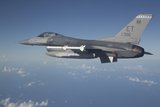General Electric wraps up second XA100 engine test series
An airflow rendering of General Electric's XA100 adaptive cycle engine. (Photo: General Electric)
General Electric has announced the completion of a second XA100 adaptive cycle engine test phase in collaboration with the USAF.
The manufacturer said on 12 September that the conclusion of the tests at USAF's Arnold Engineering Development Complex also means that a final Adaptive Engine Transition Program (AETP) contract milestone has been met.
'We now stand ready to transition to an Engineering and Manufacturing Development program and bring this engine to the field with the F-35 before the end of this decade,' said David Tweedie, GE Edison Works’ VP and general manager for Advanced Products.
'This engine isn’t a concept, proposal, or research program. This is a flight-weight, highly product-relevant engine that would provide the F-35 with 30% more range, greater than 20% faster acceleration, and significant mission systems growth to harness the F-35’s full capabilities for Block 4 upgrades, and beyond.'
The XA100 stands to 'deliver a generational change in combat propulsion performance' due to three distinct innovations, according to General Electric.
Those being an adaptive engine cycle that provides a high-thrust mode for maximum power and a high-efficiency mode for optimum fuel savings; a third-stream architecture that provides a step-change in thermal management capability and extensive use of advanced component technologies, including ceramic matrix composites, polymer matrix composites and additive manufacturing.
'These revolutionary innovations increase thrust more than 10%, improve fuel efficiency by 25%, and provide significantly more aircraft heat dissipation capacity, all within the same physical envelope as current propulsion systems,' added General Electric.
The manufacturer faces competition from Pratt and Whitney's XA101 to supply USAF with an alternative engine to the F135.
More from Defence Notes
-
![Ireland spells out $2.3 billion shopping list in five-year defence spending plan]()
Ireland spells out $2.3 billion shopping list in five-year defence spending plan
Ireland’s multi-annual investment in capital defence spending is set to rise from €300m in 2026 to €360m in 2029–2030 with major upgrades across land, air, maritime and cyber domains.
-
![Canada to deepen integration of multi-domain capabilities to strengthen its defences]()
Canada to deepen integration of multi-domain capabilities to strengthen its defences
The Canadian Department of National Defence has created new organisations to manage the procurement and integration of all-domain solutions and allocated US$258.33 million to strengthen production capacities.
-
![US National Security Strategy prioritises advanced military capabilities and national industry]()
US National Security Strategy prioritises advanced military capabilities and national industry
The 2025 NSS has emphasised investment in the US nuclear and air defence inventory and national industry, but it leaves multiple unanswered questions on how the White House will implement this approach.
-
![Canada set to look away from its neighbour and across the Atlantic for partners]()
Canada set to look away from its neighbour and across the Atlantic for partners
While non-EU UK struggles to join the Security Action for Europe initiative, which provides loans for defence programmes, Canada has become the first country outside Europe to get access – and did so for a nominal fee.
-
![NATO experiments with solutions to integrate networks, AI and uncrewed systems]()
NATO experiments with solutions to integrate networks, AI and uncrewed systems
During the latest edition of the NATO DiBaX, the alliance tested multiple capabilities to inform requirements for future efforts.
-
![Leonardo unveils plans for Michelangelo air defence dome]()
Leonardo unveils plans for Michelangelo air defence dome
The new multi-layered defence system will harness AI to neutralise airborne threats and protect Europe from Russian aggression.


























